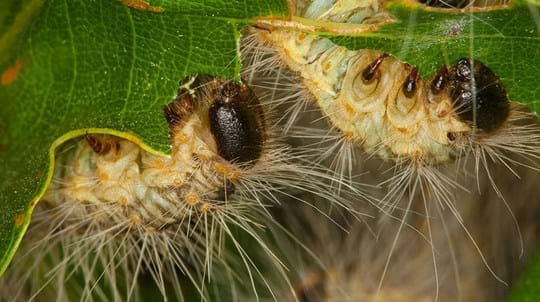
Credit: Nature Photographers Ltd / WTML
Leaves
Oval and hairless except for the tufts under the vein joints. Unlike wild cherry, the edges have fine, sharp serrations, with pointed tips and two glands on the stalk at the leaf base.
A stunning, scented show-stopper of a tree. In spring, nectar-loving animals flock to this beautiful tree for its almond-scented blossom.
Common names: bird cherry, black dogwood, hagberry, hogberry
Scientific name: Prunus padus
Family: Rosaceae
Origin: native
Mature trees can grow to 25m. The bark is smooth, peeling and greyish-brown and emits an unpleasant, acrid odour. Twigs are a dull, deep brown with pale markings. Shoots are hairy when young but become hairless with age.
Look out for: the leaf stems (petioles) which have two red glands at the top. Leaves have hairs on the underside in the vein axils.
Identified in winter by: lateral buds which are in clusters along the twig.

Credit: Nature Photographers Ltd / WTML
Oval and hairless except for the tufts under the vein joints. Unlike wild cherry, the edges have fine, sharp serrations, with pointed tips and two glands on the stalk at the leaf base.

Credit: Brian Legg / WTML
Cherry tree flowers are clustered along short stalks, botanically known as racemes. The flowers are hermaphrodite, meaning each flower has both male and female parts. Flowers appear in April. They are heavily scented, white with five petals, and measure 8–15mm across.

Credit: Nature Photographers Ltd / WTML
After being pollinated by insects, the flowers develop into reddish-black, bitter cherries. Unlike wild cherry, bird cherry does not produce root suckers.
Wild cherry (Prunus avium), sour cherry (Prunus cerasus) and cherry plum (Prunus cerasifera). The flowers of bird cherry hang in clusters.

Download our free Tree ID app for Android and iPhone to identify the UK's native and non-native trees. It's an A-Z tree guide in your pocket.
Download the app
Credit: Bob Gibbons / Alamy Stock Photo
Bird cherry is native to northern Europe and northern Asia and is common in northern England, Wales and parts of East Anglia but rarer in the southern part of Britain, especially the southwest. It’s commonly found in wet woodland, hedgerows and stream and river banks.
Like wild cherry, the spring flowers provide an early source of nectar and pollen for bees. The cherries are eaten by birds, including the blackbird and song thrush, as well as mammals such as badger, wood mouse, yellow-necked mouse and dormouse.
The foliage is eaten by caterpillars of many moth species, including the orchard ermine, brimstone and short-cloaked moth. However, it is toxic to livestock, particularly goats.

Credit: Nature Photographers Ltd / WTML
If placed at the front door, the strong-smelling bark of the tree was believed to have magical properties that could ward off the plague.
The flowers of bird cherries smell like almonds, and the sweet nectar gathered by honey bees makes great-tasting honey.
The black fruits can be used for making liqueur or for dyeing wool; while a reddish-brown dye made from the bark was once used to colour fishing nets.
Bird cherry wood is lighter and more finely textured than wild cherry and has been used for making small objects, such as wooden boxes and tool handles.
Before industrial pesticides were available, the bark of bird cherry was used as a pesticide; the chemicals it contains protecting crops from rodent and insect attacks.
Bird cherry has been used medicinally in the past for the manufacture of cough medicine; eyewash to treat conjunctivitis; and to treat kidney stones, bronchitis, anaemia and many other ailments.
Bird cherry is susceptible to bacterial cankers, which can disfigure and occasionally kill infected trees. Pruning at the wrong time of year can put trees at risk from silver leaf disease, which can also eventually kill the tree; while dieback can be caused by damage from the cherry black fly, Myzus cerasi.

Shop
We have single trees and tree packs to meet your needs, from wildlife to woodfuel. Delivery is free.
External link

Trees woods and wildlife
Learn more about the pests and diseases threatening our trees. Find out how to spot them, the symptoms and outlook, and how you can help.